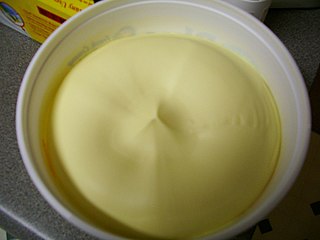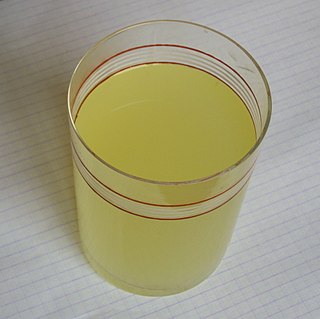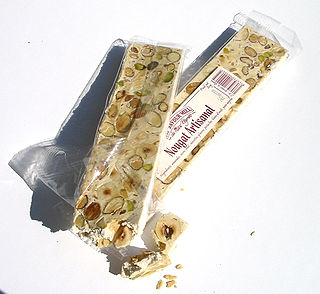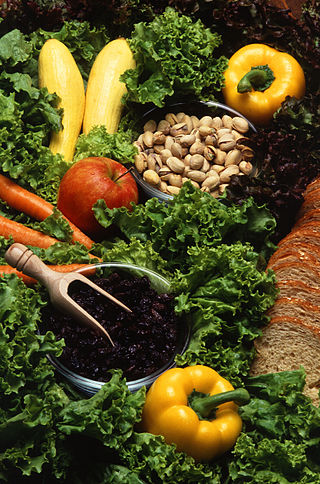
Chocolate or cocoa is a food made from roasted and ground cacao seed kernels that is available as a liquid, solid, or paste, either on its own or as a flavoring agent in other foods. Cacao has been consumed in some form for at least 5,300 years starting with the Mayo-Chinchipe culture in what is present-day Ecuador and later Mesoamerican civilizations also consumed chocolate beverages before being introduced to Europe in the 16th century.

Margarine is a spread used for flavoring, baking, and cooking. It is most often used as a substitute for butter. Although originally made from animal fats, most margarine consumed today is made from vegetable oil. The spread was originally named oleomargarine from Latin for oleum and Greek margarite. The name was later shortened to margarine.

A food pyramid is a representation of the optimal number of servings to be eaten each day from each of the basic food groups. The first pyramid was published in Sweden in 1974. The 1992 pyramid introduced by the United States Department of Agriculture (USDA) was called the "Food Guide Pyramid" or "Eating Right Pyramid". It was updated in 2005 to "MyPyramid", and then it was replaced by "MyPlate" in 2011.

Whey is the liquid remaining after milk has been curdled and strained. It is a byproduct of the manufacturing of cheese or casein and has several commercial uses. Sweet whey is a byproduct resulting from the manufacture of rennet types of hard cheese, like cheddar or Swiss cheese. Acid whey is a byproduct brought out during the making of acid types of dairy products, such as strained yogurt.

Mars, commonly known as Mars bar, is the name of two varieties of chocolate bar produced by Mars, Incorporated. It was first manufactured in 1932 in Slough, England by Forrest Mars, Sr. The bar consists of caramel and nougat coated with milk chocolate.

Nougat is a family of confections made with sugar or honey, roasted nuts, whipped egg whites, and sometimes chopped candied fruit. The consistency of nougat is chewy, and it is used in a variety of candy bars and chocolates. The word nougat comes from Occitan pan nogat, seemingly from Latin panis nucatus 'nut bread'.

Danone S.A. is a French multinational food-products corporation based in Paris. It was founded in 1919 in Barcelona, Spain. It is listed on Euronext Paris, where it is a component of the CAC 40 stock market index. Some of the company's products are branded Dannon in the United States.

The Weston A. Price Foundation (WAPF), co-founded in 1999 by Sally Fallon (Morell) and nutritionist Mary G. Enig, is a U.S. 501(c)(3) nonprofit organization dedicated to "restoring nutrient-dense foods to the American diet through education, research and activism".
3 Musketeers is a candy bar made in the United States and Canada by Mars, Incorporated. It is a candy bar consisting of chocolate-covered, fluffy, whipped nougat. It is similar to the global Milky Way bar as well as the American version of the Milky Way bar. Introduced in 1932, the 3 Musketeers Bar was the third brand produced and manufactured by M&M/Mars. Originally, each bar contained three flavors—chocolate, strawberry and vanilla—hence the name, which was derived from the 1844 novel The Three Musketeers by Alexandre Dumas. Rising costs and wartime restrictions on sugar saw the vanilla and strawberry pieces phased out, leaving only the more popular chocolate. The bars cost five cents when they were introduced, and they were marketed as one of the largest chocolate bars available.

Vegetarian nutrition is the set of health-related challenges and advantages of vegetarian diets.

Milo is a chocolate-flavoured malted powder product produced by Nestlé, typically mixed with milk, hot water, or both, to produce a beverage. It was originally developed in Australia by Thomas Mayne (1901–1995) in 1934.

Milky Way is a brand of chocolate-covered confectionery bar manufactured and marketed by Mars, Incorporated. There are two varieties: the US Milky Way bar, which is sold as the Mars bar worldwide, including Canada; and the global Milky Way bar, which is sold as the 3 Musketeers in the US and Canada.

Cyperus esculentus is a species of plant in the sedge family widespread across much of the world. It is found in most of the Eastern Hemisphere, including Southern Europe, Africa and Madagascar, as well as the Middle East and the Indian subcontinent. C. esculentus is cultivated for its edible tubers, called earth almonds or tiger nuts, as a snack food and for the preparation of horchata de chufa, a sweet, milk-like beverage.

The Hershey's Milk Chocolate Bar is a flagship chocolate bar manufactured by The Hershey Company. Hershey refers to it as "The Great American Chocolate Bar". The Hershey Milk Chocolate Bar was first sold in 1900.

PayDay is a brand of a candy bar first introduced in 1932 by the Hollywood Candy Company. The original PayDay candy bar consists of salted peanuts rolled over a nougat-like sweet caramel center. Since 1996, classic PayDay candy bars without chocolate have been continually produced by The Hershey Company. In 2020, Hershey's released a "Chocolatey PayDay bar" as a permanent part of the PayDay product line; it is identical to the regular bar, but covered by a layer of chocolate.

Freia Melkesjokolade is milk chocolate from the Norwegian chocolate brand Freia and has been the most sold chocolate in Norway since the 1960s. The chocolate was launched in 1906 after a Swiss recipe, originally called 'Freia Melkechokolade'. In the 1920s it was considered ”Europas bedste spisechokolade”, and people would often add that it was Norwegian, to underline that it was not imported. It was only after the chocolate again became available after World War II, that the name was changed to "Melkesjokolade" due to the spelling reform of 1939.

Proteins are essential nutrients for the human body. They are one of the building blocks of body tissue and can also serve as a fuel source. As a fuel, proteins provide as much energy density as carbohydrates: 4 kcal per gram; in contrast, lipids provide 9 kcal per gram. The most important aspect and defining characteristic of protein from a nutritional standpoint is its amino acid composition.

Soy protein is a protein that is isolated from soybean. It is made from soybean meal that has been dehulled and defatted. Dehulled and defatted soybeans are processed into three kinds of high protein commercial products: soy flour, concentrates, and isolates. Soy protein isolate has been used since 1959 in foods for its functional properties.

Protein bars are a convenience food that contains a high proportion of protein relative to carbohydrates and fats. Despite the label focusing on protein, many mass-marketed protein bars contain more added sugar than some desserts like cookies or doughnuts.

This is a categorically-organized list of foods. Food is any substance consumed to provide nutritional support for the body. It is produced either by plants, animals, or fungi, and contains essential nutrients, such as carbohydrates, fats, proteins, vitamins, and minerals. The substance is ingested by an organism and assimilated by the organism's cells in an effort to produce energy, maintain life, or stimulate growth.



















